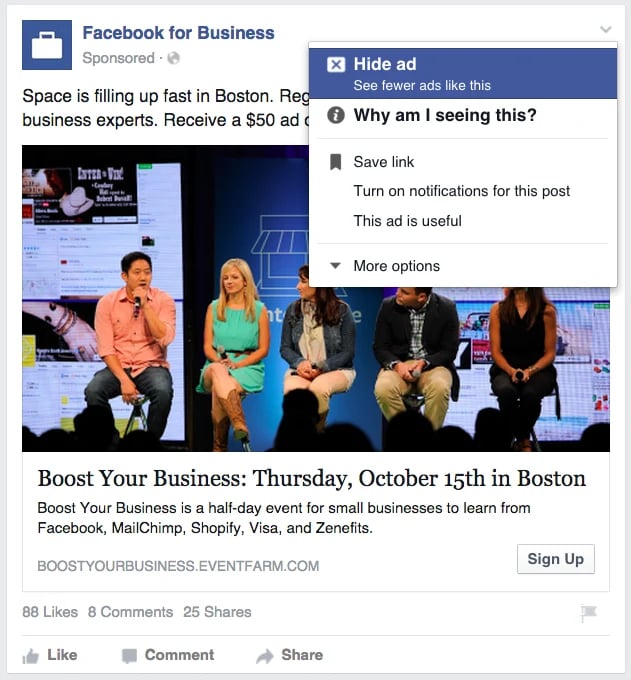When Apple unveiled its new iPhone and iOS 9operating system two weeks ago, it dropped a proverbial wet blanket on marketers everywhere: A new feature in the operating system called Content Blockers will now allow iOS 9 users to install ad blocking applications from the App Store. These ad blocking applications will let people easily block advertising, trackers, and other third-party scripts.
The new feature isn't a total shocker: Apple gave the go-ahead for iOS 9 app developers to build ad blocking extensions for Safari, its default browser app, back in June 2015. And ad blocking applications aren't a new concept -- they've actually been available for desktop and Android for a few years now.
So why is everyone freaking out? Because this is the first time Apple is allowing them for its over 700 million iPhone users. Use of the mobile Safari app represents more than half of all mobile internet usage.
There's a fair amount of confusion around what ad blocking applications are, how they work on iPhones and iPads with iOS 9, how they affect websites, and what marketers like us should do about them. We know many of you are concerned, so we're here to clear the air as much as we can. Let's dig in together.
What Are Ad Blockers?
Ad blockers are applications (like plugins or browser extensions) that remove or alter advertising content on a webpage.
Some of these applications replace that advertising content with something else. Others don't replace it with anything, leaving holes or broken links on the page where the ads would've been.
What do ad blockers block? The specific content that's disallowed varies from app to app. Some of them are meant to eliminate all advertising on a webpage. Others specifically block things that could compromise a user's privacy -- which includes the tracking codes that provide marketers with information about visitors' activities on the page (like how long a person spends looking at the page or which other pages they look at on the website).
Right now, ad blockers target the more "annoying" types of ads like pop-ups and banner ads. According to HubSpot Product Manager Lars Osterberg, Google Adwords ads are often whitelisted by default by many popular ad blockers since they're seen to be useful (and, in some cases, because they pay ad blockers to do so.)
The Pros & Cons of Ad Blocking
Blocking ads, tracking codes, and other third-party scripts benefits users by increasing page load times, improving battery life, and protecting privacy. Not to mention, you know, eliminating the annoyance of interruptive ads.
At the same time, some argue they totally undermine the infrastructure of the web. After all, advertising is how a lot of free content on the internet is supported financially. When a product is free, you are the product. Your attention is what's being bought and sold.
That's why there's a lot of controversy surrounding Apple's newfound support of these applications, and why the creator and developer of the popular ad blocking app Peace actually ended up pulling his app from the App Store.
"Ad blockers come with an important asterisk: While they do benefit a ton of people in major ways, they also hurt some, including many who don’t deserve the hit,"Arment wrote in a post to his personal blog.
“Users are inadvertently putting their favorite websites out of business,”said Sean Blanchfield, a long-time online gaming engineer who worked on Call of Duty and Guitar Hero.
Among those who ad blockers hurt are marketers -- they could potentially lose a lot of analytical data from people using iOS 9. Many of the most popular tools marketers use to measure and analyze visitors' activities on their websites -- and improve user experiences -- may be affected.
Luckily, there are ways to create content on the web that aren't affected by ad blockers. It's just a matter of understanding what they are and how they might affect your website, and then prioritizing strategies that aren't affected.
How Do Ad Blockers Work?
First, a person downloads and runs an ad blocking application, whether it's a plugin or a browser extension or something else. Then, that person opens their browser and tells it to visit a website. While that webpage is loading, the ad blocking application they downloaded looks at the site and its scripts and compares them against a list of sites and scripts it was built to block. If it finds any, it blocks them.
The ad blockers available to iOS 9 users work in much the same way, except for one difference: On iOS 9, the Safari browser app can process the list of what to block before the page even loads. The result? Much faster page load times iOS 9 users who've downloaded one of those content blockers.
Check out how page load time is improved for a Bloomberg article, for example:

Image Credit: TheNextWeb
Faster page load times, eliminating annoying ads, and more secure web browsing ... the benefits for users are crystal clear.
For marketers, not so much.
How Ad Blocking Can Affect Your Website
While ad blockers have clear benefits for users, the tools widely used by marketers to measure and improve online experiences may be affected.
(Keep in mind, by the way, that the iOS ad blocking applications only block ads for users browsing the web in the mobile Safari app. In-app ads won't be blocked for mobile users -- so anyone scrolling through their Facebook News Feed on the Facebook app will still see Facebook ads, for example.)
It can mess with your analytics.
Because many of the ad blockers available on iOS 9 block both advertisements and analytics scripts, marketers could have trouble collecting the data that gives us insights into our web visitors' behavior.
Any iOS 9 visitor to your site on the Safari app who has a script blocker installed will appear "invisible" in your analytics. So, let's say 100 people came to my website, and 10% of those people were using the Safari app and had script blockers installed. My analytics would tell me that only 90 people visited my site, and those 10 people would be totally invisible to me.
Your website could be totally functional for the end user, but you could still be losing out on critical marketing data like page views and traffic sources.
It can mess with user experience.
Some apps don't let user experience of the hook, though. Remember when I said some ad blockers don't replace blocked content with anything else? To a site visitor using one of those apps, your website might look like it's straight up missing content or has broken links. Or it could look like you traveled back in time to 1994 with just inline text and images dropped on a page.
For instance, the folks at KISSmetrics have reported missing calls-to-actions thanks to ad blockers. Below you can see what users see when they don't have the ad blocker Adblock installed (left) versus when they do (right):

Image Credit: KISSmetrics
So, What's a Marketer to Do?
While most marketers have likely run into issues caused by ad blockers on desktop, we haven't had to worry too much about this on mobile devices until now. But mobile users are more important now ever, thanks to online search on mobile devices surpassing desktop searches earlier this year.
But alas ... ad blocking technology isn't going away. The reality is that marketers will need to learn to live in a world where desktop, Android, and now iOS users have access to ad blockers for some browser applications.
Overall, this means we'll need to reevaluate and be smarter about where we spend our marketing dollars. Here's what we recommend.
1) Evaluate how well your ads are actually working for your audience.
If ads are part of your media mix, it's time to sit down and dig in to how well they're really working for your business. If you're just throwing money at advertising and not being critical about whether it's actually working, then an increase in ad blocker usage is only going to make it worse.
First, ask yourself: Does your target audience use ad blockers? If you're marketing to people who aren't super tech-savvy, then there might only be a small chunk of your audience using ad blocking technology ... and you may not need to worry as much. But if you're marketing to a more tech-savvy crowd (like gamers, where all of this ad blocking technology originated) then you'll have to worry more.
Who tends to use ad blocking technology, you might be asking? While it's too soon for there to be any significant studies on the demographic of people downloading ad blocking apps on iOS 9, Adobe and PageFair conducted a study on ad blocker usage in 2014 that gave us a better idea of the demographic of people who use ad blockers.
For example, they found ad blocking is most popular with millennials: 41% of people between 18-29 years old say they use ad blocking software. They also found that men are 48% more likely than women to use ad blocking software when browsing the internet.
Next, do some research to find out how your prospects and customers really feel about your ads. Do they like them and think they're helpful, or do they totally hate them? If your audiences like the way you advertise, you might be on to something. If they hate them, well ... you'll need to restrategize.
You can ask your customers using a survey. The big networks like Facebook, Twitter, Google, and LinkedIn also offer feedback loops that'll give you an idea of whether people like your ads on those networks.
For example, Facebook calls this metric "negative feedback," which is "a rating based on the number of times your audience hit your ad or otherwise indicated a negative experience, such as choosing not to see ads from you." If your negative feedback is high, it means people don't want to see your ad.

At the end of the day, make sure your ads are making money for your business. Watch your metrics closely, and if you're seeing that ads aren't affecting your bottom line -- or, even worse, if you're seeing a noticeable decline -- then it's definitely time to rethink your strategy.
2) Focus on ad viewability.
Real talk: Are your ads even being seen? Digital ad fraud has always been an issue for advertisers: Before the iOS 9 update, a study from ANA found that 11% of online display ads and 23% of video ads aren't actually displayed to real people. Instead, they're being seen by robots creating fake impressions and clicks.
Now, we have to worry about ads being hidden or removed from our websites by ad blockers, which would render those views and impressions invisible altogether to our marketing analytics. This won't just affect display and banner ads; it could also affect native ads for iOS 9 users using ad blockers who are browsing the internet on Safari.
If you're advertising on Google, the Google Display Network will help tell you how many of your ads are actually being viewed by people. They're trying to set a new standard in the industry by only counting an impression if they're confident it's being seen by a real human.
Marketers who use display advertising in their marketing strategy should take the same approach, says Marcus Andrews, product marketing manager at HubSpot. They should demand viewability, and be more critical and more focused on making sure their ads are being seen -- and restrategizing and reprioritizing if they're not.
3) Choose ad networks that have a more inbound approach to advertising.
Google's display network was engineered to measure true viewability for display advertisements -- as in, only reporting the number of actual humans they believe views those ad.
Facebook's changes are also geared toward creating better experiences for its users. This includes their News Feed updates, which give users more and more control over which content they're shown in the News Feed. It also includes Facebook's approach to native advertising, which encourages marketers to advertise their content in a way that doesn't feel like an advertisement.
LinkedIn's Sponsored Updates take a similar approach by letting users not only reach a broader audience than their followers, but also by promoting content that's relevant, helpful, and interesting to that audience.
(Remember: While some of the most popular iOS ad blocking applications can still block native advertisements in the Safari browser, they won't be able to block them for mobile users who are viewing the in-app advertisements.)
So put your money with ad networks like Google, Facebook, LinkedIn, and Twitter because they're doing advertising the best right now. And if you want to advertise with publishers, here's a directory of HubSpot-verified publishers that are some of the best and most trusted out there.
4) Take a more inbound approach yourself.
Being hooked on advertising has never been sustainable -- but now, it can put marketers in an even more precarious spot. The rise of ad blocking on mobile is yet another reason for marketers to think: Should inbound marketing be a bigger part of my mix?
Increase organic traffic to your website instead of relying on referral sources by building out your website's blog and content. Every time you write a blog post, it's one more indexed page on your website. Every new indexed page is one more opportunity for you to show up in search engines and drive organic traffic to your website. (Read this blog post for more tips on building out your company's blog.)
Now that Apple's opened the doors for ad blockers for such a huge online audience, it's more important than ever for marketers to be smart about where they invest their advertising resources. They want to avoid getting their ads blocked -- and, you know, create better ad experiences for their site visitors.





.jpg)






